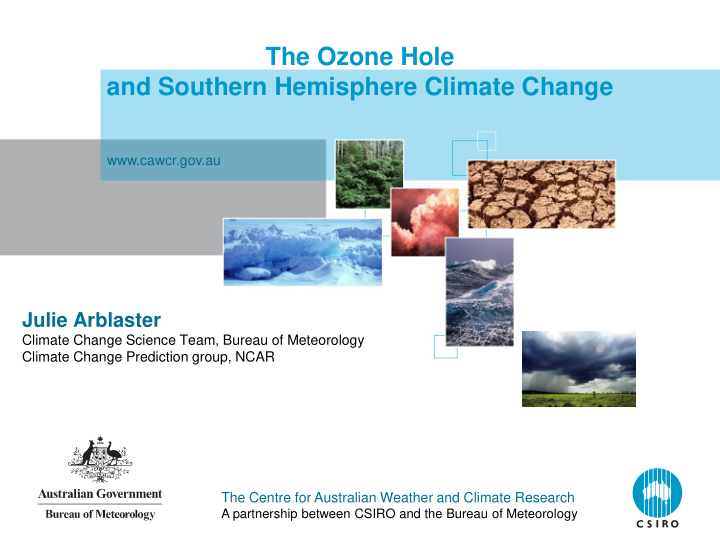



The Ozone Hole and Southern Hemisphere Climate Change www.cawcr.gov.au Julie Arblaster Climate Change Science Team, Bureau of Meteorology Climate Change Prediction group, NCAR The Centre for Australian Weather and Climate Research A partnership between CSIRO and the Bureau of Meteorology
The Ozone Hole and climate change Ozone depletion over Antarctica of more than 50% compared to 1980 levels Predominantly in spring months, impact on surface climate in summer Recovery of the ozone hole projected by mid-late 21 st Century Stratospheric ozone has only a minor impact on global surface temperatures NASA
Ozone depletion and Southern Hemisphere atmospheric circulation Depletion => cooling in Antarctic stratosphere => changes in atmospheric circulation and rainfall DRY WET recent research suggests jet has moved poleward by ~2 latitude since 1979 Son et al 2010
Ozone depletion and Southern Hemisphere atmospheric circulation Southern Annular Mode (SAM) index measures strength & position of winds SAM index => Ozone impacts SAM & surface climate predominantly in summer => Recent trend in the SAM due primarily to ozone depletion Thompson et al. Nature Geosciences, 2011
Impacts on surface climate Impacts of increasing summertime SAM (~ozone depletion) implications for Antarctic sea-ice, ice sheets and carbon uptake by the Southern Ocean sea surface temperature & wind surface temperature & wind Thompson et al. Nature Geosciences, 2011
Impacts on summer surface climate temperature rainfall Impacts of increasing summertime Southern Annular Mode (~ozone depletion) Warm over New Zealand, dry in west, rainfall wet in east Wet and cool over southern Australia Thompson et al. Nature Geosciences, 2011
Climate model experiments Recent studies show these impacts can be captured by climate models observed summer rainfall change from 1979-2000 climate model summer rainfall change driven by ozone depletion Kang et al., Science, 2011
What of the future? <= past future => Son et al 2010
Future changes in the Southern Hemisphere GHGs Son et al 2010
Ozone depletion and atmospheric circulation Southern Annular Mode (SAM) index measures strength & position of winds SAM index Ozone depletion and greenhouse gases act together to drive past changes SAM index Ozone recovery and greenhouse gases drive opposite changes Thompson et al. Nature Geosciences, 2011
Climate modelling intercomparison project New opportunities to assess the role of ozone versus greenhouse gases on the SH circulation in lead up to IPCC 5 th Assessment Report: – all models include ozone recovery into the future – a number of chemistry-climate models participating – a number of high-top models participating Stratospheric ozone depletion and recovery included in all participating models Meehl et al, J Climate, 2012 and Cionni et al 2011
Future climate change scenarios a poleward shift in the SH extratropical circulation ( westerly jet, SAM ) is one of the most robust responses to global warming ozone recovery will offset this shift in austral summer to some extent which forcing dominates in future climate change scenarios? => low-emissions scenario RCP2.6: ozone recovery wins and SH winds shift equatorward => high-emissions scenario RCP8.5: GHGs wins and SH winds poleward Meehl et al. J Climate 2012
Conclusions The ozone hole has driven tropopause much of the observed shift in Southern Hemisphere mid- height latitude winds during summer with broad impacts on surface ? climate Ozone recovery will offset the south pole response to climate change to equator some extent Many recent papers on understanding impacts of stratospheric ozone in recent and future trends - ties to changes in Tropics eg. Hadley Cell and subtropics - much work on proposed mechanisms - potential impacts on extremes
The Centre for Australian Weather and Climate Research A partnership between CSIRO and the Bureau of Meteorology Julie Arblaster Climate Change Science Team, CAWCR Climate Change Prediction group, NCAR Email: j.arblaster@bom.gov.au Thank you www.cawcr.gov.au
Recommend
More recommend